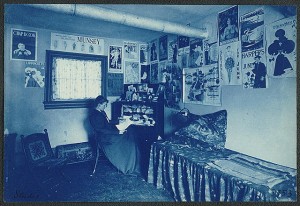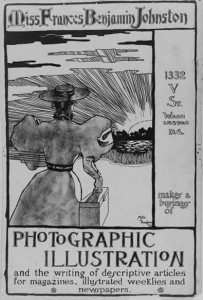Mills Thompson (1875-1944)
Miss Frances Benjamin Johnston, 1332 V St., Washington, D.C., makes a living of photographic illustration and the writing of descriptive articles for magazines, illustrated weeklies and newspapers, 1895
Poster illustration advertising Frances Benjamin Johnston’s photographic business
Ink on paper
Cabinet of American Illustration in the Library of Congress
Frances Benjamin Johnston (1864-1962) was one of the earliest American women to be a professional photographer. Trained as an artist at the Académie Julian in Paris and later at the Washington, D. C. Art Students League, Fannie, as she was called, was given her first camera by George Eastman, the inventor of Eastman Kodak cameras, who was a friend of her family. She began working as a freelance photographer in the 1890s, taking photographic portraits of friends and family and location shots while touring Europe.
Taking up work in a man’s world was not a new concept for Fannie. Her mother, Frances Antoinette Johnston, worked as a congressional journalist for the Baltimore Sun. Familiar with the Washington political scene, Fannie eventually became the official White House photographer for the Harrison, Cleveland, McKinley, T.R. Roosevelt and Taft presidential administrations.
In 1895, Fannie’s friend and fellow artist, J. Mills Thompson, created a poster to advertise her photography business. Thompson represented the fashionably clothed Fannie as an intrepid photo-journalist. She strides away from the viewer and toward the rising sun coming up over a city beyond the water (could be the Potomac) with a photographic plate carrier box in her right hand and a tripod under her left arm. Above the hat on her head, the clouds and morning mist burn off with the growing heat from the blazing sun.

Frances Benjamin Johnston (1875-1944) | Photograph of Frances Benjamin Johnston seated at a desk in her studio/office, between 1890 and 1900 | Cyanotype | Library of Congress Prints and Photographs Division
Frances Benjamin Johnston liked and collected contemporary posters. As you can see in the photograph taken of her in her home office, various contemporary advertising posters are tacked up on her walls. Some of the posters are so recognizable, that we can identify particulars of her collection. On the wall surrounding the window from left to right in the top row we can recognize Will Bradley’s 1895 Chap Book poster; Kenyon Cox’s 1895 poster advertising a new book, Scribner’s: The Last Quarter Century in America; and Edward Penfield’s May 1895 Harper’s magazine poster. In the row of posters below we can see Will Carqueville’s July 1895 Lippincott’s magazine poster with the exploding fire works; and another Bradley poster for The Chap Book for May 1895. On the adjacent wall from left to right we can recognize Carqueville’s poster for Lippincotts February 1895 issue; Edward Penfield’s poster for Harper’s April 1895 featuring Joan of Arc; Carqueville’s Lippincott’s for May 1895; and June 1895; distinctively different is Charles Dana Gibson’s poster of a young lady riding a bicycle for the June 1895 issue of Scribner’s magazine; and Edward Penfield’s Harper’s poster for June 1895 showing a young man in his cap and gown for graduation. At the far right appears to be an unidentified poster for the newspaper the New York World.
While I cannot identify every poster on her study walls, Johnston seems to have preferred posters related to magazines and newspapers and most of them decorated with images of women. Comparing the posters on her wall and the poster designed for her by Mills Thompson we can see that Miss Johnston preferred images of women with whom she could identify. These images reveal women who are actively engaged in their world not only through the knowledge they’ve gained via reading current periodicals but also in both their vigorous and contemplative activities. But it is the Gibson poster of the young woman riding her bicycle that provides the most clues. Gibson’s girl wears a straw boater hat with a flat crown, a shirtwaist blouse with voluminous leg-of-mutton sleeves tucked into the waist of her bloomers, baggy pants gathered at the waist and ankle that allowed for more vigorous physical activity such as bicycle riding. In Thompson’s poster the image of Johnston may be posed with her back to the viewer, but she clearly wears her own summer straw boater hat and her dress bodice sports equally voluminous sleeves (also called a gigot sleeve) as she pursues her profession. Like Gibson’s active ‘new woman’ character used to advertise Scribner’s magazine, Mills Thompson’s poster for his friend and fellow artist, Francis Benjamin Johnston, he represents her as an active ‘new woman’ photographer intrepidly moving through the world in business-like fashion. I love that Johnston called her business “Photographic Illustration” on the poster, reminding us how central the illustration arts were in that moment.
* The “new woman” was the description of a new feminist ideal that emerged in the late nineteenth century and referred to women who pushed the traditional limits of what a woman could do in a male-dominated society. Interestingly Frances Benjamin Johnston wrote an article in an 1897 issue of the Ladies Home Journal titled, “What a Woman Can Do with a Camera” in which she wrote, “Photography as a profession should appeal particularly to women, and in it there are great opportunities for a good-paying business. . . .”
December 1, 2011
By Joyce K. Schiller, Curator, the Rockwell Center for American Visual Studies, at the Norman Rockwell Museum







